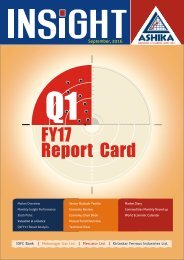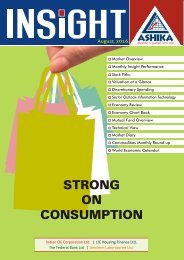Ashika Monthly Insight August 2016
You also want an ePaper? Increase the reach of your titles
YUMPU automatically turns print PDFs into web optimized ePapers that Google loves.
STRONG ON CONSUMPTION<br />
Source: Motilal Oswal Presentation; Note: Discretionary items include Health<br />
care, Education & Recreation, Communication, Transportation, Personal<br />
products & services, Housing & Utilities and Food, beverages & Tobacco<br />
7th Pay commission to boost consumer demand<br />
Government approved a 16% increase in pay and 23.6%<br />
hike in pensions for central government employees, in<br />
line with the seventh pay commission’s recommendations.<br />
However, government refrained from approving 63%<br />
increase in allowances. The 7th PC will affect 4.7 million<br />
central government employees and 5.3 million pensioners<br />
and it will be implemented from January 1, <strong>2016</strong>. 7th PC<br />
payout will be favorable for consumption though its<br />
impact on aggregate demand would be less than 6th PC.<br />
Payout this time is likely to be ~1.2% of GDP over 2<br />
years, which would be nearly half of what was realized<br />
under 6th PC. In 6th PC the average pay hike was 60%<br />
and total payout for government was 2.5% of GDP over 2<br />
years. Further, in 7th PC the time arrears are just for 3<br />
months versus 3 years in 6th PC. Higher wages would<br />
drive demand growth for consumer discretionary items<br />
such as automobiles, clothing and footwear. Rise in<br />
automobile growth is considered as an indicator of<br />
economic boom which grew over 20% in FY10 compared<br />
with 7.4% in the year prior to the 6th PC implementation.<br />
Historically, it had been noticed that wage hike by<br />
government stroke higher CPI inflation due to increase in<br />
HRA of government employees and pay rise which boost<br />
discretionary demand. Post the implementation of 6th PC<br />
CPI services inflation rose from 4.4% in FY08 to 7.4%<br />
during FY09. Higher disposable income will find an outlet<br />
through both discretionary categories as well as staples.<br />
This will not only spur the demand, but also give<br />
economic growth a fillip. According to India Ratings &<br />
Research, the pay package will boost consumption in the<br />
economy by Rs 45,110 crore (0.3% of GDP) and increase<br />
savings by Rs 30,710 crore (0.2% of GDP). The report also<br />
estimated that the central government’s net tax revenue<br />
(after sharing with states) will increase by Rs 14,100 crore<br />
(0.09% of GDP) post 7th PC. As per the report the full<br />
impact of the pay hike would be felt in FY18, when bigticket<br />
items get a fillip. For instance, real estate off-take<br />
will kick-off with lag effect. As far as the auto sector is<br />
concerned, government employees and pensioners<br />
accounted for 10-15% of the 2.78 million passenger<br />
vehicles sold in India during FY16 and pay hike can bring<br />
more buyers, resulting in higher demand for passenger<br />
vehicles. The pay commission will put extra money in the<br />
hands of a large section of Indian consumers, thus spurring<br />
the demand for discretionary and aspirational products<br />
which could positively impact consumer durables sector.<br />
Rising demand for consumer durable products, cars and<br />
housing would drive the retail lending growth, thus could<br />
have affirmative impact on banks and NBFCs.<br />
% of GDP<br />
6th PC<br />
7th PC<br />
Source: Industry report<br />
Rural demand to drive discretionary spending on the<br />
backdrop of good monsoon<br />
Rural economy had been depressed in last two years as<br />
two consecutive years of drought have taken a toll on rural<br />
household incomes. But an ‘above normal’ monsoon, as<br />
predicted by India Meteorological Department (IMD), could<br />
boost rural demand which in turn, could have a positive<br />
impact on overall economy. A report by Goldman Sachs<br />
stated that if the rural economy grows by one percentage<br />
point, it could potentially boost overall gross domestic<br />
23






